Las vírgenes generalas: acción guerrera y práctica religiosa en las campañas del Alto Perú y el Río de la Plata (1810-1818)
Abstract
The aim of this paper is to demonstrate that during the wars of independence, religious practice was a fundamental preoccupation of both royalists and the armies that fought for independence. This was not due exclusively to the personal devotion of the generals involved, but was also because of the political and institutional function religion had in the process of war. Firstly we investigate how both sides used the Marian cult in the practice of war, following on a long Hispanic tradition. Both armies named different avocations of the Virgin as their Generals. This was a novelty in the history of war in both Peru and the Río de la Plata, as before they had been merely patrons of the regiments. Secondly we note how this conscious instrumentalization by the generals, had different emphases and shades depending on the maneuvers adopted by the enemy in a context of propaganda war. We dedicate our effort to restoring the ‘religious thread’ during the arc of 1810 to 1818, from the three campaigns of the Army of the North to the victories of San Martín and Bernardo O’Higgins in Chile. We show how Catholic liturgy was not only the most efficient strategy with which to create a regular and disciplined army, but also a way so that soldiers (within the militia) and the people (from without the militia) would believe in the sacredness of the independence cause.Downloads
The copyright is transferred to the Boletín, but the authors may retrieve them and reproduce their work in other media or formats by means of a written request to the Editorial Committee. In such cases, the Boletín will be cited as the first publication of the work.
The works are licensed under a Creative Commons Attribution-NonCommercial 4.0 International License, which allows others to share the work with an acknowledgment of their authorship and initial publication in this journal.
Also, by written request to the Editorial Committee of the Boletín, the authors may separately establish additional agreements for the non-exclusive distribution of the version of the work published in this journal (for example, placing it in an institutional repository or publishing it in a book), with an acknowledgement of its initial publication here. No commercial uses are allowed.



















